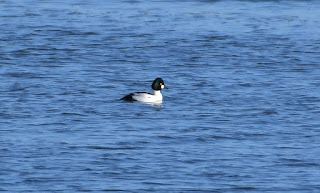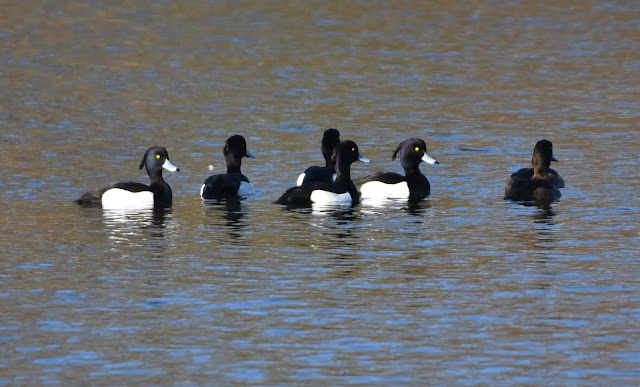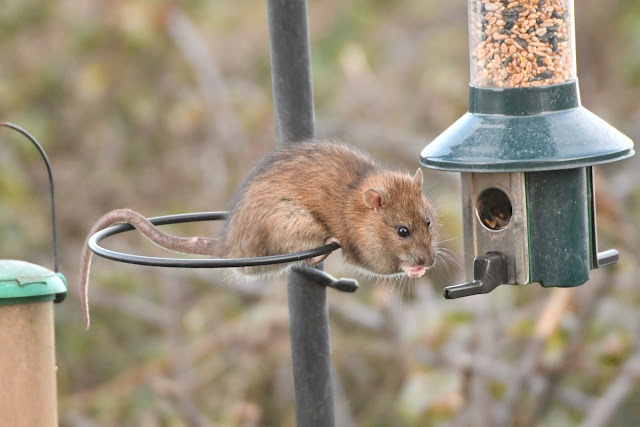Pennington just before sunrise is a special place to start the day. Especially when the day is bright and clear and is forecast to stay that way until sunset.
I met Chris at the small car park at the end of Lower Pennington Lane for our day's walk. The view as I got out of the van was of the flooded fields that are utilised by the wildfowl and waders in winter. It invariably dries up come spring and into summer.
Walking south we reached the first of the lagoons that border the Solent with the Isle of Wight in the background.
The birds were just stirring and coming out of their roosting sites as the light increased.
Upon reaching the high seawall everything was still, barely a ripple on the sea, we hardly needed words, we just stood and absorbed the calmness in virtual silence while waiting for the sun to pop it's head above the island and bask in it's golden rays.
It's only at times like these that we actually get to see the speed in which the sun rises or how quickly we revolve around it. The rest of the day is taken almost for granted as it moves up and over our heads. The only other time is sunset of course. Made me feel quite small in the big picture of things.
The moon wasn't to be outdone and put in a reasonable show too.
My eye was drawn to one of my favourite plants. Normally the reeds are in constant movement - barely a flicker today...
Hurst Castle that juts out impressively into the narrow stretch of the Solent, almost touching the island was feeling the first shards of sunlight. The narrow spit that connects the castle and lighthouse is almost 1.5 miles long and is a killer on the legs if you fancy trudging it's whole length on the stones. Luckily there is a boat service that connects to Keyhaven harbour for those less able.
Now the soft light of the early sun was reaching inland, our attention turned to Fishtail Lagoon over our shoulders. We have never seen it so flooded. Even the lower path beneath us was consumed.
Birds were beginning to stir including a Mute Swan which gave a couple of flypasts for us.
Pintail too. One of our favourite ducks.
In the surrounding bushes many small birds were feeding or just seeming to enjoy the perfect conditions such as this male Reed Bunting.
The tide was receding, exposing the soft mud which is jam packed with food for all manner of waterbirds.
A Greenshank flew into Butts Bay opposite Fishtail to begin feeding as the water flowed out.
A Little Egret was already in place, ready to catch any unsuspecting tiddlers as they fled through the ever narrowing channels.
The sun was still low and giving the best soft light , picking out the Greenshank beautifully.
We began walking East along the seawall in search of more treasure. Out in the bay the waders were now in force, taking the opportunity to feed while the sun shone and the tide was low.
Bar Tailed Godwits are regular visitors here in winter but normally in single figures. It's cousin, the Black Tailed Godwit is more ubiquitous and can be seen either along the shore or on inland lakes and soft ground whereas the Bar Tailed is usually just a coastline specialist.
It was feeding close to the smaller Dunlin that visit here in their thousands.
Next lagoon along was Pennington with what we first thought was a Shag drying it's wings in the classic Phoenix pose. There were some around but this was a juvenile Cormorant which can be distinguished by the yellow base of the bill and light grey lower mandible.
The colours showed subtle purples, blues and black. A very beautiful and overlooked bird in my opinion. Not a favourite of anglers, especially on inland lakes.
Teal always pepper the lagoon edge and more often than not - asleep!
Out on the shore near the old jetty the large spit was now exposed. Normally it is crowded with waders but only another Cormorant sat drying it's wings today.
Plus a Curlew out picking morsels in the shallows.
We decided to walk out onto the spit as it was clear, partly because I had seen some Slavonian Grebes close inshore. The are notorious for feeding well out of decent camera range so we took the opportunity to get a little closer, especially as the sea was like a mill pond.
There were four in total close together which was quite unusual. They visit coastlines in winter but breed on lakes in Scotland and Northern Europe. Their summer plumage is quite stunning with ginger tufts either side of the head and a russet red neck and body.
We were back on the seawall path, the reflections in the lagoons were incredible. Here's me trying something different as some Brent Geese flew overhead, trying to catch their reflections in the water. Doesn't always work !
Oxey Lagoon was next up. I saw someone looking at the opposite bank. A lone wader was sat, half asleep which was unusual as they should be feeding at low tide. Our initial thoughts were the rare Semi- Palmated Sandpiper we had discovered here last November. It had been seen again recently so on first deduction in the bright light we thought it that again. Only after cross examination and much conjecture we had to settle on a common Dunlin. Whilst it's hundreds of companions were out feeding at low tide this was sat alone. There's a possibility it was unwell.
The sea path zigzags into and around Oxey Creek. Either in the bay or the lagoons, there's always something to see. A male Goldeneye duck was out in the bay. This is a usual spot to see them. A good feeding area it seems.
Oxey Marsh is another place to come across regulars. Spotted Redshank love feeding here and they didn't disappoint this time either.
The now very sharp light gave challenges between dark and light contrasts in photography.
I'm not particularly happy with the results but it was a record of the birds nonetheless.
I quite like the light picking out the primaries in their wings in flight against the texture of the water.
Avocet were scattered across the creek and mostly distant. Thirteen or fourteen in total with just the one continuing to feed out in the bay.
As we crossed Moses Dock it gave a great view of how low tide looks across the creek to Oxey Bay.
Across from the dock is Salterns Marsh, another place where Spotted Redshank love to feed. No luck here this time but a Common Redshank did put in a good show close in. Known as the sentinel of the marsh they are usually the first to be spooked as you walk by, but not this time.
As we wound our way around the coastal path I spotted that classic blue flash of a Kingfisher and watched it as it settled on the wall of the old harbour some distance away.
Another Greenshank flew onto the mudbank to feed opposite the Kingfisher as we stood trying to get that little bit closer before it flew off.
With the Kingfisher long gone in no small part of the many humans and dogs walking around we carried on past the boating lake near the eastern edge of the reserve by Normandy Marsh. Another regular spot to see certain birds. The ones in question being Tufted Ducks. Five males trying to gain the attention of a single female. Just a slight ratio difference.
Our last few corners brought us to Normandy Marsh which harbours probably the most diverse amount of species of all the lagoons along this stretch of coastline. The next and last port of call is Lymington Harbour where the Wightlink ferry departs to Yarmouth on the Isle of Wight.
We rarely walk that far as humans and boats aren't on our list to photograph.
As we rounded the last corner, Chris nonchalantly passed comment of a Spoonbill feeding close to the seawall. I took it initially as a joke until I clapped eyes on the bird in question. They don't normally feed here which goes some way to explain why I thought he was taking the piss. That is our way at times...
But there it was plain as day. Quite a stunning bird. Without doubt due in no small part to it's unfeasibly disproportionate bill. Also being quite rare in real terms this side of the channel. Ten years ago I would have been amazed at one feeding before us.
Time of day was around lunchtime so many people were around. Most noticeably - dog walkers. The bane of our time out walking I have to say.
Firstly this is a nature reserve with posters pleading with owners to keep their charges either close to heel or on a lead to stop unwanted disturbance.
More often than not this is disregarded or completely ignored. I've had arguments with people when I have calmly asked them to control their dogs. 'They've got wings, they'll fly back' I've had spat back at me in anger. Well, quite frankly they will fly back but they expend so much energy with constant disturbance and worry in limited winter daylight it leaves them on the brink of survival. So if you own a dog and enjoy a walk in nature, please think twice if your's runs around unguarded and unchecked. It really can mean a knife edge between life and death.
As it happened, we spoke to a couple with an errant dog. 'Oh, he just loves the mud, not the birds' she said. I explained that this may be the case but it still disturbs the birds.
My case bore fruit as the Spoonbill took flight...
This individual's black primary feathers giving away it's juvenile age.
It was time to head back to the car park for lunch and our second part of the day. As we turned the corner back from Moses Dock I looked through my binoculars to the low tide peninsular which was covered in seaweed with Turnstones feeding in amongst the detritus. I caught sight of a slightly greyer, lighter bird between them. I knew immediately it was a Purple Sandpiper.
These are uncommon winter visitors along our coastline. There are around a dozen or less that visit Southsea Castle every season which we saw the week before but one individual seems to love fraternising with the Turnstones here every year too.
We left it to feed in peace at low tide.
Returning back to Oxey Lagoon, another Spoonbill was feeding. This was an adult, different from the one we saw off Normandy.
They have an unmistakable swirling feeding routine. When it feels a morsel beneath the surface it flicks it in the air to swallow it whole.
Such a lovely little grebe even in winter plumage and an amazing red eye.
The Cormorant was still drying it's wings. Maybe it had been out feeding since our last pass?
Along with the Cormorant it had a close friend. Occasionally a Red Breasted Merganser will settle in the lagoon. They are regularly seen out at sea feeding but with timing you can see one up close here.
This lovely male was taking time to preen and splash in the fresh water. It must make a change to the salt waters of the Solent.
By now the Cormorant was back feeding in the lagoon. The dark water against the bird provided great photo opportunities.
Lunch was very much welcomed back at the car park before our trek down the back footpath of the lagoons, heading west towards Keyhaven.
Our quarry was the ever elusive Short Eared Owl. It had been seen here in the past few days but we are ever sceptical and with good reason. These raptors are always on the move and with constant flooding in the area, it's a toss up and good luck where you might cross paths.
We did manage to cross paths with Roe Deer however. This Buck was present with two Doe.
Being early Winter, at least in name , Snowdrops had begun to emerge. Their usual spot near Keyhaven is a good place to see them.
Opposite the harbour there is a small nature reserve run by local volunteers. Chris has a membership so we can gain access to the tiny hide overlooking the reeds and channel there. The feeders they provide are great for Sparrows and Water rails pick up the grain scattered below. Rats also take advantage of the feast. We watched one clever youngster ascend the seemingly unscalable pole to feed from the port.
Our last journey took the seawall path back to the car park.
We passed a couple of people seemingly just staring at the sea. They pointed out a basking Harbour Seal. Also known as a Common Seal. There is a small colony along the coast here.
We were nearing Fishtail Lagoon once more, our circular walk almost complete. Constantly looking over our shoulders into the fields behind us clinging to the hope of the owl out hunting. Sadly it wasn't to be - again!
We were able to catch a distant glimpse of a Peregrine Falcon sat on it's favourite block out on the saltmarsh. There was another perched not far away too.
More Spoonbill wandered around the channels while the tide wasn't too high. Five were together there with a couple more behind us on Keyhaven Lagoon.
This is another juvenile in flight. The black wingtips the giveaway.
Large flocks of Dunlin fizzed around the distant shore. No doubt disturbed by the Peregrines which had left their roosting perches.
There were lots of movement as we stood for the last few moments before heading home.
Pintail again..
And Shelduck..
The lowering sun reflected beautifully on the still lagoons. Time for some arty shots...
The golden glow of the last rays picked out anything that happened past us.
A female Stonechat..
Plus a close up of a male and female Wigeon. These winter migrants have a distinctive whistling call that reminds me so much of this time of season.
A last glimpse of The Needles on the western tip of the Isle of Wight and a couple more sunset shots before we walked back to the car park and the journey home.
Quite a stunning day weather wise with nature playing ball apart from that Short Eared Owl. We'll get to see one again one day ,of that I have no doubt.
The title of this post is an excerpt from the poem 'Winter Sun' by Peter S Quinn
https://www.poemhunter.com/poem/winter-sun-7/



















































































































































